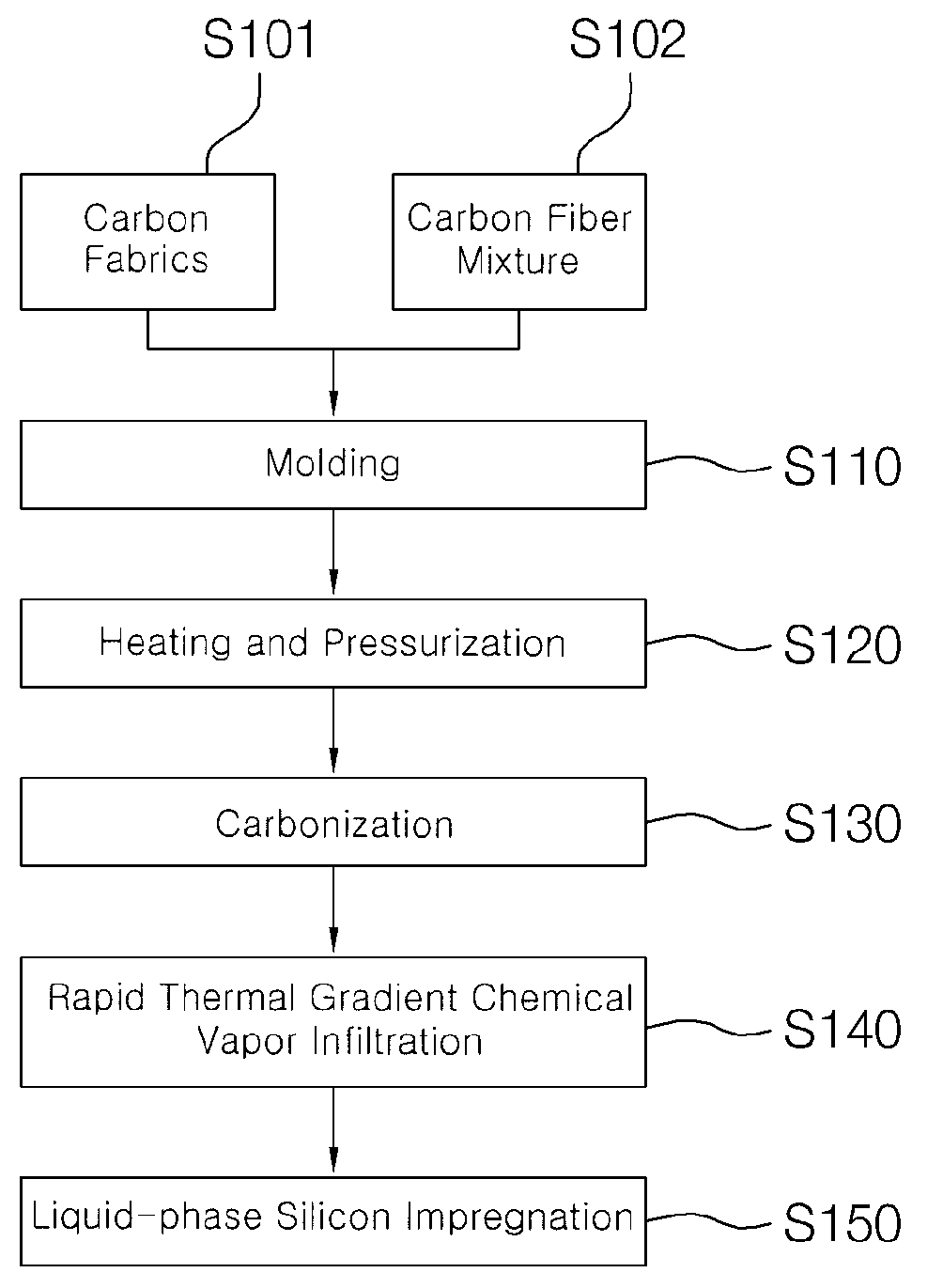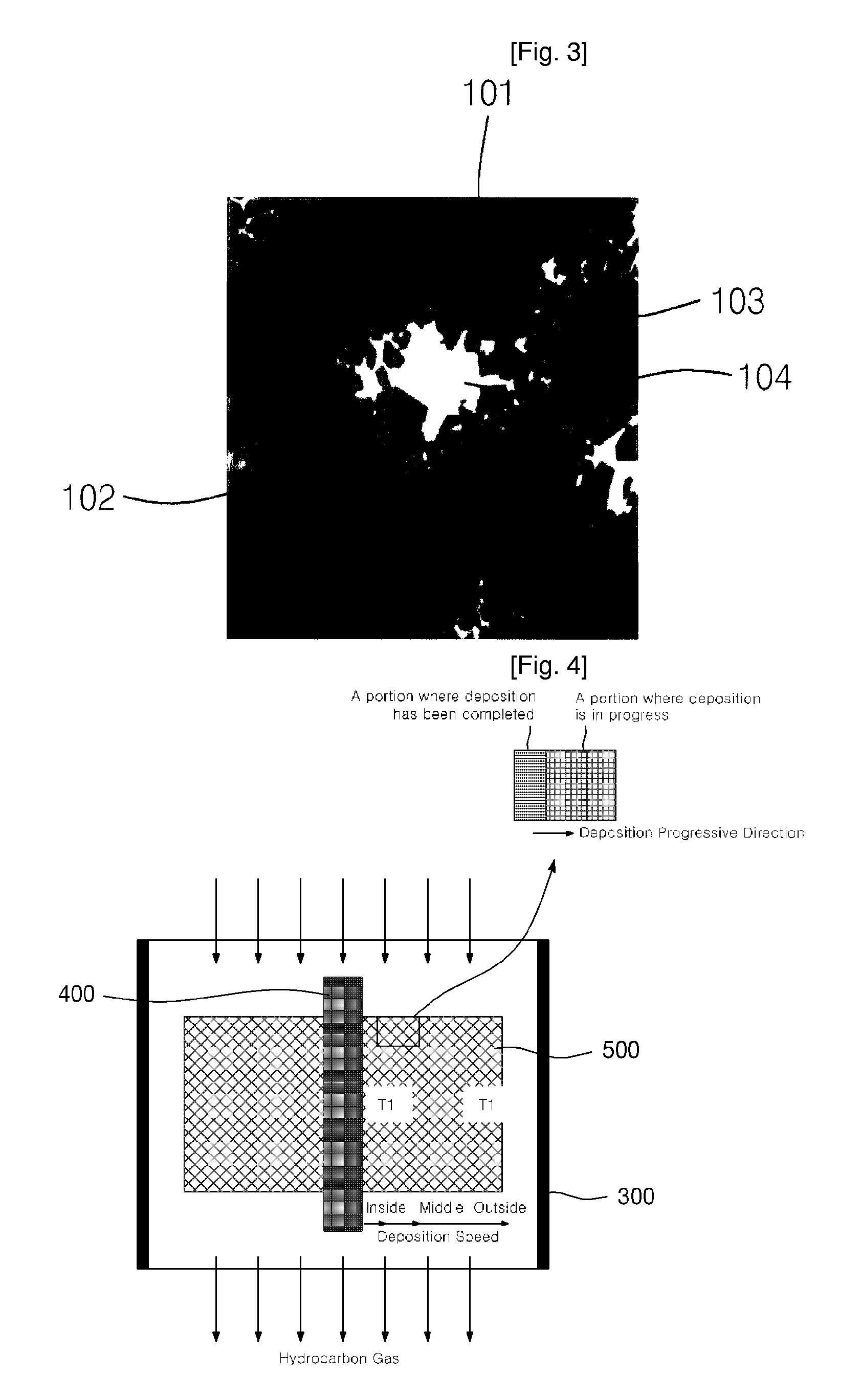Method of Producing Carbon Fiber Reinforced Ceramic Matrix Composites
- Summary
- Abstract
- Description
- Claims
- Application Information
AI Technical Summary
Benefits of technology
Problems solved by technology
Method used
Image
Examples
first embodiment
[0066]A mixture comprising 30 wt % carbon fibers that have been cut out in the size of 30 mm, 40 wt % phenol resin, 5 wt % carbon powder, and 5 wt % silicon carbide powder is prepared and stacked alternately with carbon fabrics in the form of 20 wt % satin weave to produce a green body. The produced green body is placed in a mold, and then cured while being pressurized at a pressure 2 MPa for 10 minutes to produce a carbon fiber reinforced resin composite.
[0067]The carbon fiber reinforced resin composite is subjected to thermal treatment in inert gas atmosphere. Furthermore, pyrolytic carbon is deposited in a condition of rapid thermal gradient chemical vapor infiltration process to produce a carbon fiber reinforced carbon composite.
[0068]The produced carbon fiber reinforced carbon composite is stacked on silicon powder, and heated at 1,550° C. in vacuum atmosphere, and infiltrated with liquid-phase silicon to produce a carbon fiber reinforced ceramic matrix composite. Here, physica...
second embodiment
[0069]A mixture comprising 55 wt % carbon fibers that have been cut out in the size of 30 mm, 35 wt % phenol resin, 5 wt % carbon powder, and 5 wt % silicon carbide powder is prepared to produce a green body. Stacking alternately with carbon fabrics is not implemented in the second embodiment. The produced green body is placed in the mold, and then cured while being pressurized at a pressure 2 MPa for 10 minutes to produce a carbon fiber reinforced resin composite.
[0070]The carbon fiber reinforced resin composite is subjected to thermal treatment in inert gas atmosphere. Furthermore, pyrolytic carbon is deposited in a condition of rapid thermal gradient chemical vapor infiltration process to produce a carbon fiber reinforced carbon composite.
[0071]The produced carbon fiber reinforced carbon composite is stacked on silicon powder, and heated at 1,550° C. in vacuum atmosphere, and infiltrated with liquid-phase silicon to produce a carbon fiber reinforced ceramic matrix composite. Here...
third embodiment
[0072]320K oxyphene carbon fiber is wound around a mandrel to produce unidirectional carbon mats, and the carbon mats produced by this method are stacked together. For stacking method, they are stacked alternately by a method of 0 / +60 / −60°.
[0073]At least two layers are stacked together, and then punched using a needle to reinforce every layer in the z-direction, and the process is reiterated to produce a felt preform having 30 mm in thickness. This felt preform is produced at approximately 45% of oxyphene fiber volume ratio, where the thickness of a layer is approximately 0.9 mm, and the fiber ratio in the z-direction is approximately 10%.
[0074]The produced preform is subjected to thermal treatment at 1,700° C. in vacuum atmosphere to remove the impurities of the preform.
[0075]Pyrolytic carbon is deposited on the produced carbon felt preform in a condition of rapid thermal gradient chemical vapor infiltration process to produce a carbon fiber reinforced carbon composite.
[0076]The pr...
PUM
| Property | Measurement | Unit |
|---|---|---|
| Temperature | aaaaa | aaaaa |
| Temperature | aaaaa | aaaaa |
| Length | aaaaa | aaaaa |
Abstract
Description
Claims
Application Information
 Login to View More
Login to View More - R&D
- Intellectual Property
- Life Sciences
- Materials
- Tech Scout
- Unparalleled Data Quality
- Higher Quality Content
- 60% Fewer Hallucinations
Browse by: Latest US Patents, China's latest patents, Technical Efficacy Thesaurus, Application Domain, Technology Topic, Popular Technical Reports.
© 2025 PatSnap. All rights reserved.Legal|Privacy policy|Modern Slavery Act Transparency Statement|Sitemap|About US| Contact US: help@patsnap.com



